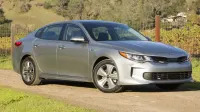Automatically efficient | 2017 Kia Optima Hybrid Quick Spin

That’s inevitably led to powertrain innovations designed to maximize just how long and how far hybrids can run on pure electric power and how often the gas engine can shut down. Occasionally, this doesn’t work out all that well – as is the case with the new Nissan Rogue Hybrid, for instance – but there are companies getting things right. Kia, with its 2017 Optima Hybrid, is one of them.
Drive Notes
- Kia didn’t try to get too creative with the Optima Hybrid’s powertrain for 2017. There’s a 2.0-liter, naturally aspirated, four-cylinder gas engine, a 38-kilowatt electric motor, and a 1.62-kWh battery pack. Total system output is 192 horsepower and 271 pound-feet of torque, with EPA estimated fuel economy ratings of 39 miles per gallon in the city and 46 mpg on the highway for a 42-mpg combined rating. That’s all spiffy.
- But taking a six-speed automatic and replacing the torque converter with a clutch and the electric motor, Kia built a hybrid sedan that smoothly intertwines disparate power sources as well as a conventional hybrid like a Toyota Prius, while allowing the Optima Hybrid to take greater advantage of zero-emissions systems. Lift off the throttle and the four-cylinder engine shuts down and lets the 50-hp electric motor handle light, constant-throttle cruising below 62 miles per hour. Dig deeper into the gas, and the petrol powerplant quickly restarts and delivers the bulk of the Optima’s power for heavy acceleration and higher-speed conditions. The Optima’s back and forth is rarely disjointed – Kia’s hybrid feels a lot like its conventionally powered model in normal driving. It’s only under sudden, wide-open throttle situations, where the hybrid systems feel caught off guard, that the Optima Hybrid feels flatfooted.
- A less obvious benefit of the six-speed automatic, of course, is that it leads to quieter operation. There’s no rubber-band-like revving like you’d get with a CVT because the transmission can actually shift up a gear. Now, the Optima’s 2.0-liter doesn’t sound bad – we wouldn’t complain about the noise if there was a CVT here – but the lack of noise is a pleasant side effect of the six-speed auto.
- The actual power on offer, meanwhile, falls somewhere between that of a base Optima and the turbocharged SX – unsurprisingly, there’s a lot more low-end torque, owing to the electric motor. The Optima Hybrid feels snappier than the base, 2.4-liter Optima, but it fades at higher rpm and simply doesn’t feel as potent as the 2.0-liter, turbocharged car.
- Powertrain tweaks aside, the Optima Hybrid rides and handles largely like its gas-only counterpart. That’s to say the steering is light and pleasant, but doesn’t do a great job transmitting finer road detail to the driver’s hands. The ride is heavily biased towards comfort – a Mazda6 this isn’t – but it feels perfectly average in a turn, with predictable levels of body roll, squat, and dive.
- Like with previous Optima Hybrids, Kia cribbed major elements from the Hyundai Sonata Hybrid. While the powertrain is the most obvious carryover, the Optima also shares the same impressively low coefficient of drag as the Hyundai, despite the obviously different sheetmetal. The big addition is active grille shutters, but changes to the front and rear fascias and more-aerodynamic wheels all have a positive impact on how the Optima cuts through the air.
- Kia optimized the exterior for aerodynamics, but the Optima Hybrid’s cabin is largely unchanged – same clean but conservative dash, adequate material quality, and comfortable seats. The main thing you’re losing out on with the Hybrid, at least in the cabin, is the gas-powered SX Limited’s upgraded interior trim, like the lovely quilted leather seats. Keep that in mind if you’re an upholstery snob.
- In the inevitable comparison of fuel economy, the Optima Hybrid scores well for highway drivers. Its 46-mpg highway rating is five above the Ford Fusion Hybrid’s, eight above the Toyota Camry Hybrid’s, and only one behind the new Honda Accord Hybrid’s. Things aren’t as rosy for the Optima Hybrid in the city – its 39-mpg city rating is down four on the Ford, three on the Camry, and eight on the Accord. The Optima’s 42-mpg combined rating wins out against the 40-mpg Toyota, ties the Ford, and is six points behind the Honda.
- Prices for the base Optima Hybrid Premium start at $26,845. That’s $3,855 more than the gas-only Optima LX, or the equivalent of 1,706 gallons of gas at today’s AAA national average, $2.26 per gallon of 87 octane. That works out to about 108 fillings of the Optima Hybrid’s 15.85-gallon fuel tank – assuming the owner nets the car’s 46-mpg highway rating, there’s 729 miles to a tank. At 12,000 miles per year, owners would only refuel 16.4 times. In other words, you’d need to drive for just over six and a half years before seeing a return on the purchase of an Optima Hybrid Premium. With the Optima Hybrid EX’s $5,850 premium over the gas-powered EX, the range-topping hybrid is an even tougher purchase to justify.
So no, the Optima Hybrid does not make good financial sense right now. But not only can we make the same argument against the competition from Ford, Honda, and Toyota, we’re relying on extremely affordable gas prices. With that in mind, the Optima Hybrid, like any hybrid, is a calculated gamble – buyers are essentially hoping to insulate themselves in case of a sudden and dramatic increase in fuel prices. That the Optima Hybrid does this while maintaining largely unchanged driving dynamics, looks, and comfort as the gas-only version makes this an easier commitment.
Related Video:




